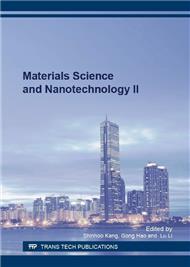[1]
Liu M, Deng Q, Zhao F, et al. Origin of hydrogen sulfide in coal seams in China. Safety Science, 50(2012)668-673.
DOI: 10.1016/j.ssci.2011.08.054
Google Scholar
[2]
Liu Keqi, HaoXuefeng. Advances in Intensive Geological Evaluation Methods of the Mature Exploration Areas. Journal of Southwest Petroleum University: Science & Technology Edition, 37(2015)11-18.
Google Scholar
[3]
Lei Wang, Hongjun Yin, Xiaoshuang Yang, et al. Analysis for pressure transient of coalbed methane reservoir based on Laplace transform finite difference method. Petroleum, 1(2015) 231–236.
DOI: 10.1016/j.petlm.2015.08.002
Google Scholar
[4]
Lin H, Wei W, Wang Y-N, et al. Study on the rapid removal of H2S in underground coal mines. Journal of China Coal Society, 37 (2012) 2065-(2069).
Google Scholar
[5]
WANG Y, LIANG B, YUAN X. The application of deep hole pre-split blasting to gas improved extraction in high hydrogen sulphide mine. Journal of Chongqing University, 36 (2013)101-106.
Google Scholar
[6]
Bolourinejad P, Herber R. Experimental investigation of porosity and permeability variations in reservoirs and caprock following co-injection of sulfur dioxide and hydrogen sulfide with carbon dioxide. Journal of Petroleum Science and Engineering, 129 (2015).
DOI: 10.1016/j.petrol.2015.02.036
Google Scholar
[7]
Zhang Z, Liu B, Wang F, et al. Hydrogen sulfide removal from hot coal gas by various mesoporous silica supported Mn2 O3sorbents. Applied Surface Science, 313 (2014) 961-969.
DOI: 10.1016/j.apsusc.2014.06.116
Google Scholar
[8]
Quanshu Li, Huilin Xing, Jianjun Liu, et al. A Review on Hydraulic Fracturing of Unconventional Reservoir. Petroleum, 1(2015)8-15.
Google Scholar
[9]
Li Hong, TianHongyuan, Liu Jianjun. Time and Space Change of Permeability for Rock Mass in Dam Abutment High Slopes of Hydropower Engineering. Journal of Southwest Petroleum University(Natural Science Edition), 37(2015)152-159.
Google Scholar
[10]
Leyong Chen, Jianjun Liu. Numerical analysis on the crack propagation and failure characteristics of rocks with double fissures under the uniaxial compression. Petroleum, 1(2015)373-381.
DOI: 10.1016/j.petlm.2015.10.009
Google Scholar
[11]
Huang S, Liao F, Wu X, et al. Distribution characteristics of hydrogen sulphide-bearing gas pools and the genesis of hydrogen sulphide in Sichuan Basin. Nat Gas Geoscience, 21 (2010) 705-714.
Google Scholar
[12]
Liu Jianjun, Song Rui, Cui Mengmeng. Improvement of predictions of petrophysical transport behavior using three-dimensional finite volume element model with micro-CT images. Journal of Hydrodynamics, 27(2015)234-241.
DOI: 10.1016/s1001-6058(15)60477-2
Google Scholar
[13]
Gou Feifei, Liu Jianjun, Liu Weidong. Numerical Simulation of Chemical Transferring Using Finite Difference Method. Journal of Southwest Petroleum University(Natural Science Edition), 37(2015)112-118.
Google Scholar
[14]
Qingang Zhang, Yang Ju, Wenbo Gong, et al. Numerical simulations of seepage flow in rough single rock fractures. Petroleum, 1(2015)200-205.
DOI: 10.1016/j.petlm.2015.09.003
Google Scholar
[15]
Fan Xiaojun. Control Sedimentation Characteristics of Upper Permian Changxing Formation in Yuanba Area and Its Control Action for Reservoir. Journal of Southwest Petroleum University: Science & Technology Edition, 37(2015)39-48.
Google Scholar
[16]
Asaoka S, Okamura H, Akita Y, et al. Regeneration of manganese oxide as adsorption sites for hydrogen sulfide on granulated coal ash. Chemical Engineering Journal, 254 (2014) 531-537.
DOI: 10.1016/j.cej.2014.06.005
Google Scholar
[17]
Zhu G, Dai J, Zhang S, et al. Generation mechanism and distribution characteristics of hydrogen sulfide bearing gas in China. Natural gas geoscience, 15(2004)166-170.
Google Scholar
[18]
Kang Yili, Zhang Dujie, You Lijun, et al. Mechanism and Control Methods of the Working Fluid Damages in Fractured Tight Reservoirs. Journal of Southwest Petroleum University: Science & Technology Edition, 37(2015)77-84.
Google Scholar
[19]
Tsuji H, Tanno K, Nakajima A, et al. Hydrogen sulfide formation characteristics of pulverized coal combustion–Evaluation of blended combustion of two bituminous coals. Fuel, 158 (2015) 523-529.
DOI: 10.1016/j.fuel.2015.06.001
Google Scholar
[20]
XuXiaoming, Li Yanlan, He Hui, et al. Optimization of Injection-production Patterns of Fan Delta Distributary Channel. Journal of Southwest Petroleum University: Science & Technology Edition, 37(2015)98-104.
Google Scholar
[21]
Zhang Tingshan, Wu Kunyu, Yang Yang, et al. Evidence of Microbial Origin of Organic Matters of Niutitang Shale Gas Reservoir. Journal of Southwest Petroleum University: Science & Technology Edition, 37(2015)1-10.
Google Scholar
[22]
Francesco Carducci, Antonio Del Monaco, Giancarlo Giacchetta, et al. Development and application of an innovative tool to automate the process of results extraction from the thermo-hydraulic simulator Olga. Petroleum, 1(2015)164-168.
DOI: 10.1016/j.petlm.2015.06.003
Google Scholar
[23]
Tsang YF, Wang L, Chua H. Simultaneous hydrogen sulphide and ammonia removal in a biotrickling filter: Crossed inhibitory effects among selected pollutants and microbial community change. Chemical Engineering Journal, 281 (2015) 389-396.
DOI: 10.1016/j.cej.2015.06.107
Google Scholar
[24]
Shirai H, Ikeda M, Aramaki H. Characteristics of hydrogen sulfide formation in pulverized coal combustion. Fuel, 114(2013) 114-119.
DOI: 10.1016/j.fuel.2012.03.028
Google Scholar


